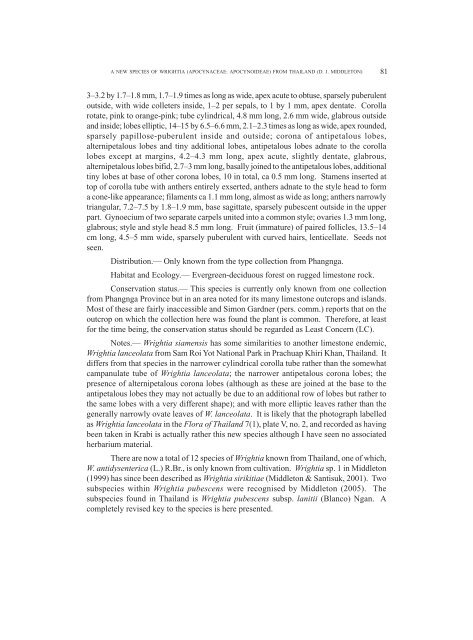A new species of Wrightia(Apocynaceae: Apocynoideae) from ...
A new species of Wrightia(Apocynaceae: Apocynoideae) from ...
A new species of Wrightia(Apocynaceae: Apocynoideae) from ...
Create successful ePaper yourself
Turn your PDF publications into a flip-book with our unique Google optimized e-Paper software.
A NEW SPECIES OF WRIGHTIA (APOCYNACEAE: APOCYNOIDEAE) FROM THAILAND (D. J. MIDDLETON)<br />
3–3.2 by 1.7–1.8 mm, 1.7–1.9 times as long as wide, apex acute to obtuse, sparsely puberulent<br />
outside, with wide colleters inside, 1–2 per sepals, to 1 by 1 mm, apex dentate. Corolla<br />
rotate, pink to orange-pink; tube cylindrical, 4.8 mm long, 2.6 mm wide, glabrous outside<br />
and inside; lobes elliptic, 14–15 by 6.5–6.6 mm, 2.1–2.3 times as long as wide, apex rounded,<br />
sparsely papillose-puberulent inside and outside; corona <strong>of</strong> antipetalous lobes,<br />
alternipetalous lobes and tiny additional lobes, antipetalous lobes adnate to the corolla<br />
lobes except at margins, 4.2–4.3 mm long, apex acute, slightly dentate, glabrous,<br />
alternipetalous lobes bifid, 2.7–3 mm long, basally joined to the antipetalous lobes, additional<br />
tiny lobes at base <strong>of</strong> other corona lobes, 10 in total, ca 0.5 mm long. Stamens inserted at<br />
top <strong>of</strong> corolla tube with anthers entirely exserted, anthers adnate to the style head to form<br />
a cone-like appearance; filaments ca 1.1 mm long, almost as wide as long; anthers narrowly<br />
triangular, 7.2–7.5 by 1.8–1.9 mm, base sagittate, sparsely pubescent outside in the upper<br />
part. Gynoecium <strong>of</strong> two separate carpels united into a common style; ovaries 1.3 mm long,<br />
glabrous; style and style head 8.5 mm long. Fruit (immature) <strong>of</strong> paired follicles, 13.5–14<br />
cm long, 4.5–5 mm wide, sparsely puberulent with curved hairs, lenticellate. Seeds not<br />
seen.<br />
Distribution.— Only known <strong>from</strong> the type collection <strong>from</strong> Phangnga.<br />
Habitat and Ecology.— Evergreen-deciduous forest on rugged limestone rock.<br />
Conservation status.— This <strong>species</strong> is currently only known <strong>from</strong> one collection<br />
<strong>from</strong> Phangnga Province but in an area noted for its many limestone outcrops and islands.<br />
Most <strong>of</strong> these are fairly inaccessible and Simon Gardner (pers. comm.) reports that on the<br />
outcrop on which the collection here was found the plant is common. Therefore, at least<br />
for the time being, the conservation status should be regarded as Least Concern (LC).<br />
Notes.— <strong>Wrightia</strong> siamensis has some similarities to another limestone endemic,<br />
<strong>Wrightia</strong> lanceolata <strong>from</strong> Sam Roi Yot National Park in Prachuap Khiri Khan, Thailand. It<br />
differs <strong>from</strong> that <strong>species</strong> in the narrower cylindrical corolla tube rather than the somewhat<br />
campanulate tube <strong>of</strong> <strong>Wrightia</strong> lanceolata; the narrower antipetalous corona lobes; the<br />
presence <strong>of</strong> alternipetalous corona lobes (although as these are joined at the base to the<br />
antipetalous lobes they may not actually be due to an additional row <strong>of</strong> lobes but rather to<br />
the same lobes with a very different shape); and with more elliptic leaves rather than the<br />
generally narrowly ovate leaves <strong>of</strong> W. lanceolata. It is likely that the photograph labelled<br />
as <strong>Wrightia</strong> lanceolata in the Flora <strong>of</strong> Thailand 7(1), plate V, no. 2, and recorded as having<br />
been taken in Krabi is actually rather this <strong>new</strong> <strong>species</strong> although I have seen no associated<br />
herbarium material.<br />
There are now a total <strong>of</strong> 12 <strong>species</strong> <strong>of</strong> <strong>Wrightia</strong> known <strong>from</strong> Thailand, one <strong>of</strong> which,<br />
W. antidysenterica (L.) R.Br., is only known <strong>from</strong> cultivation. <strong>Wrightia</strong> sp. 1 in Middleton<br />
(1999) has since been described as <strong>Wrightia</strong> sirikitiae (Middleton & Santisuk, 2001). Two<br />
sub<strong>species</strong> within <strong>Wrightia</strong> pubescens were recognised by Middleton (2005). The<br />
sub<strong>species</strong> found in Thailand is <strong>Wrightia</strong> pubescens subsp. lanitii (Blanco) Ngan. A<br />
completely revised key to the <strong>species</strong> is here presented.<br />
81
















